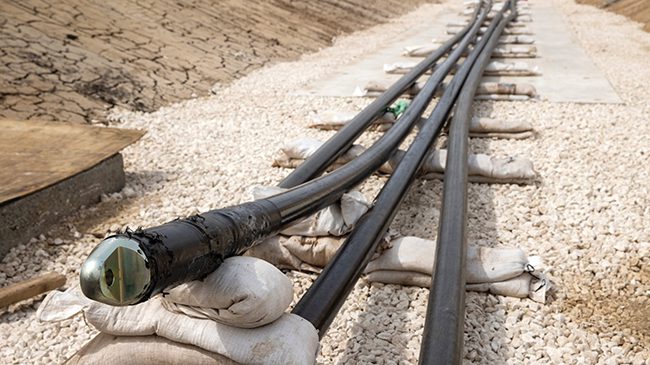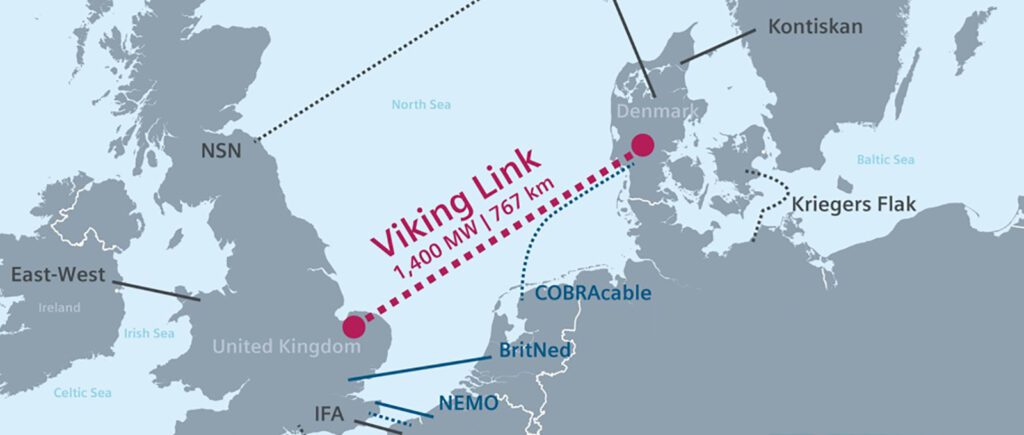Viking Link: The Epic Build of the World's Longest Onshore and Subsea HVDC Interconnector

A marvel of modern engineering, Viking Link—the world’s longest onshore and subsea interconnector—began commercial operations in December 2023. The project garners POWER’s inaugural Transmission and Distribution (T&D) Award for its many stellar attributes, including the milestones and innovations that have defined its journey.
Since the first commercial high-voltage direct-current (HVDC) transmission link was energized between the Swedish mainland and the island of Gotland in 1954, submarine interconnectors have multiplied, growing more sophisticated with advancements in cable design, new materials and alloys, and installation techniques. In 2021, UK-based energy multinational National Grid and Norwegian system operator Statnett marked the commercial operation of the 1.4-GW North Sea Link, which stretches 447 miles under the North Sea between the UK and Norway at a depth of nearly half a mile. That project continues to hold a distinction as the longest subsea interconnector in the world.
But on Dec. 29, 2023, National Grid, through its competitive subsidiary National Grid Ventures (NGV), in partnership with Danish system operator Energinet, energized an even longer 1.4-GW line—Viking Link—which stretches 475 miles under land and sea to join Bicker Fen substation in Lincolnshire, UK, with Revsing substation in southern Jutland, Denmark.
While the £1.7 billion ($2.2 billion)±525-kV DC project will continue to operate at a maximum 800-MW cap until 2025 to suit Danish grid system limitations, Viking Link in April 2024 earned the Guinness world record as the longest land and subsea HVDC interconnector (Figure 1). However, as it was being built, the five-year project also marked several notable firsts, including the use of a hydrogen fuel cell system to provide off-grid power during construction and the deployment of the state-of-the-art cable-laying vessel, the Leonardo da Vinci, built by Italian cable manufacturer Prysmian.
|
|
Laying the Foundation
According to National Grid, the vision for Viking Link was conceived in 2015 as Europe began to explore a more resilient and interconnected grid. While Denmark is part of the Nord Pool power market and already had good links with Sweden, Germany, and Norway, the interconnector promised a new high-price market for its growing fleet of onshore and offshore wind.
For Great Britain, a link would allow access to a “well-developed, low-cost market with prices set by a diversified energy mix from across Scandinavia and Northern Germany,” it said. At the time, prominently, wind generation outputs between the UK and Denmark showed low correlation and periods of high production were unlikely to occur at the same time in both countries, the company explained.

The project officially grew into a business pursuit when in July 2016, the European Union (EU) selected Viking Link for a Connecting Europe Facility (CEF) grant, through which the EU co-funded its final development costs. (NGV and Energinet separately funded the project’s construction costs.)
By December 2016, the partners had consulted on two cable route corridors. Detailed seabed surveys, utilizing six specialized offshore vessels, in the North Sea then identified the optimal route for the 385-mile submarine cable portion. The surveys, conducted with 93,000 manhours by independent marine consultant Fugro Survey BV, studied seabed conditions to minimize environmental impacts, support engineering perspective, and identify an appropriate design specification for the cables.
That work led to investment approvals by the Danish Minister for Energy, Utility, and Climate in October 2017. Uncertainty shrouding planning consents in the UK, however, delayed a final investment decision (FID), given that the consents formed the basis for the offshore and onshore construction work. By December 2018, despite hurdles with a local planning authority in the UK for the onshore portion, most of the project’s applications were approved.
Rapid Development and Collaboration
After NGV and Energinet set out a plan to commission Viking Link by 2023, project development began rapidly evolving. In early 2019, the partners set up a Joint Ownership and Operations Agreement (JOOA) and began placing contracts. By August 2019, it secured crucial contracts with Siemens Energy for the supply and installation of equipment for two converter station sites in Lincolnshire, UK, and Revsing, Denmark. Contracts for the project’s two parallel HVDC cables, meanwhile, went to Prysmian Powerlink S.r.l. and NKT HV Cables AB.
Prysmian’s €700 million contract, notably, included the turnkey design, manufacturing, and installation of 1,400 kilometers (870 miles) of cabling. As the company noted, the order for cabling was substantial. Given the tight schedule, it began organizing all activities for cable manufacture at its Arco Felice (Italy) facility “well in advance” of the order. The proactive approach proved beneficial in light of the COVID-19 pandemic. By May 2020, Prysmian reported it had successfully conducted factory acceptance tests for its first cable. “The manufacturing of cable is a very critical part of the entire project, as even the slightest hiccup can result in delays that build up along the line,” noted Fabrizio Traversi, Prysmian Group project director.
Construction formally kicked off in July 2020. Siemens Energy noted it set to work on the two converter stations, mobilizing “the highest standards, with a particular focus on the latest sustainability and low-carbon construction techniques.” The identical 300-square-meter converter stations, used to convert alternating-current (AC) to DC, and vice versa, would eventually house HVDC PLUS technology. Aligned to Siemens converter system specifications, the exterior and interior of the building, built by Danish construction firm MT Højgaard, is designed by Rambøll, with decorations made by Viking Age tattoo artist Luciano Pezzoli.
UK-based multinational infrastructure firm Balfour Beatty, meanwhile, spearheaded a $117 million contract for the UK onshore civil works. Balfour Beatty was responsible for the civil engineering and installation of 42 miles of HV cabling across Lincolnshire, connecting Denmark to Great Britain at National Grid’s Bicker Fen substation.
Just a few months later, Danish firm Munck Piping started 92 horizontal directional drills (HDD) to lay cables manufactured by NKT in Denmark under dunes from Houstrup Beach near Blaabjerg to the converter station in Revsing by Vejen. “Horizontal directional drilling is used to avoid digging and making an open cable trench in areas where you need to reduce disturbance from construction work—for example, when crossing roads, railways, water streams, etc.,” NGV explained.
An Innovative Legacy
A particularly innovative part of the project involved Siemens Energy installing a zero-emission hydrogen fuel cell to provide off-grid power for the project’s construction in Lincolnshire (Figure 3). Given that it wouldn’t have a grid connection for at least six to eight months, the fuel cell nixed the need for diesel generators, providing 250 kVA of standard three-phase 400V power, 216 kWh of battery storage to smooth peaks in power demand, up to 80 kW of heating to about 20 cabins across the construction villages, and power for six electric vehicles. Siemens Energy’s partner, GeoPura, directed the fuel cell’s waste heat through heat exchangers to heat water, which was then piped to two drying rooms for the site workers’ personal protective equipment.

From 2021 to 2023, the heavy submarine cables (weighing about 40 kilograms per meter) were laid at depths of 3,000 meters over the North Sea route by the inaugural run of Prysmian’s $185 million advanced cable-laying vessel, Leonardo da Vinci (Figure 4), and buried using Asso trenchers. “This is the world’s most advanced cable-laying vessel, and with two rotating platforms of 7,000 and 10,000 tons—the highest carousel capacity in the market—it can store and install longer lengths of cable, thus requiring fewer joints and installation campaigns, and significantly improving the overall project efficiency,” said Prysmian.

By November 2022, the UK site had received the first two of its seven massive Siemens Energy transformers—each weighing as much as “54 elephants.” The Danish portion received its seven transformers in April 2023 (Figure 5). Final cable testing was completed in July 2023, joining the UK and Danish grids for the first time. The project achieved commercial operation in December 2023, wrapping up more than four million working hours for the teams in the UK and Denmark.
![Global logistics and shipping firm Bertling Logistics delivered the seven Siemens Energy 225-tonne transformers from Rotterdam via the Port of Esbjerg to the project site in Vejen, Denmark. Züst & Bachmeier transported seven other transformers to the UK site at Bicker Fen.“The transformers measured 7.50 x 4.64 x 5.00 [meters] and had to be assembled on-site in front of the transformer bay before being jacked and skidded onto the foundation,” Bertling says. Courtesy: Bertling Logistics](jpg/vikinglink-transformers-bertling.jpg)
For now, Viking Link is expected to deliver “£5.2 billion [$6.8 billion] in consumer benefit over 25 years,” National Grid noted. “These calculations were made by Ofgem as part of the Cap and Floor assessment for Viking Link. In its first year, Viking Link is expected to save more than 600,000 tonnes of carbon emissions based on the same metrics as the above.”

—Sonal Patel is a POWER senior editor (@sonalcpatel, @POWERmagazine).
